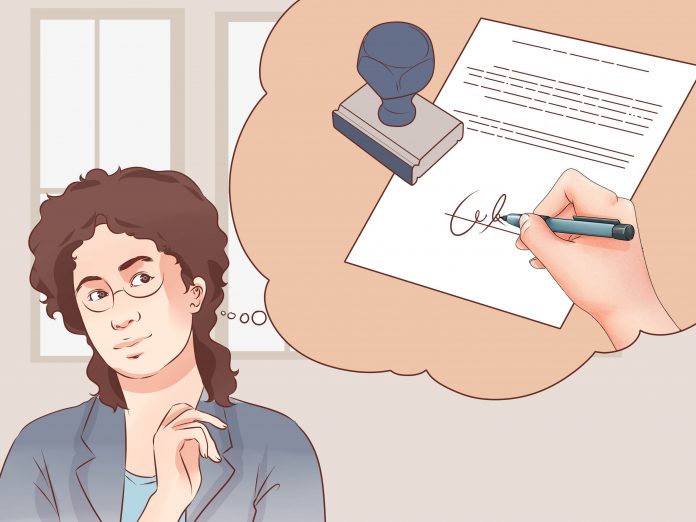This article is written by Pratha Kotecha who is pursuing a Diploma in Advanced Contract Drafting, Negotiation, and Dispute Resolution from Lawsikho.
Table of Contents
Introduction
We use affidavits to present evidence to the court. At times, the courts accept evidence orally from a witness, however, for evidence without a witness – like receipts, photographs, or personal accounts of facts in the case the evidence must be presented through affidavits.
Affidavit- definition
An affidavit is a sworn written statement that is used in court proceedings. It can also be defined as a statement of facts accompanied by an oath. According to the dictionary definition of Merriam Webster, an Affidavit is a sworn statement in writing made especially under oath or on affirmation before an authorized magistrate or officer. An affidavit is treated as “evidence” within the meaning prescribed in Section 3 of the Evidence Act. Submitting a false affidavit before authority is a punishable offense.
An affidavit contains important facts that are within that person’s own knowledge which the party wants the judge to know. The witness swears it under affirm or an oath before a registry clerk or a lawyer. Swearing means making a promise that the information contained or made in the affidavit is accurate and true. An affidavit must be signed by the person who is giving the affidavit and their signature must be witnessed by a lawyer or some other well-qualified person.
Courts will usually only accept affidavits that are written and witnessed in compliance with that particular court’s rules. Most affidavits can be completed by any person but they must be notarized before they are considered valid. An affidavit can also have exhibits- which may be letters or other important documents attached with it. The affidavit is to be filed in the court registry and the copies of the same have to be given to all other persons who are named in the lawsuit.  Who can create an affidavit and the parties involved?
Who can create an affidavit and the parties involved?
In order to create an affidavit, an individual should not be a minor and must have attained majority. He should be in a position to understand the nature of the contents sworn. In other words, the person should not be insane or incapacitated to the extent of not knowing the meaning of the statements mentioned in the affidavit. However, minors may be asked to sign an affidavit in a family court matter, as long as the minor is of sound mind and is of an age where he or she is old enough to understand the facts and that the minor is signing a document that must be true and correct. In preparation for an affidavit, the following parties are involved:
- Court or statutory body: The affidavit is submitted to this authority. The purpose behind preparation is to authenticate the statement of truth before the relevant authority.
- Deponent: The person who writes or files an affidavit for any reason is called a deponent.
- The Oath Commissioner or the Notary Public: It is the person who testifies the signature of the deponent and further adds his signature and seal on the affidavit in order to authenticate it.
- Witnesses: To prove the authenticity of the affidavit, normally two witnesses are required to sign it.
Uses of affidavit
Affidavits are used whenever there is an intention to swear an oath of any nature. For example- in passport requirements, divorce proceedings, verification, property disputes, notification, debt cases among others. It is also used in the event of loss of certificates or original documents of any nature, for purposes of changing names of individuals, and for a number of different reasons.
According to the laws of India, an affidavit can be used to substantiate a fact in an appropriate forum or before appropriate authority, provided that the court orders it. As affidavits are not included in the definition of ‘Evidence’ in the Indian Evidence Act, 1872, they can be considered as evidence only when the court finds it reasonable to invoke the provisions of Order 19 of the Civil Procedure Code, 1908. This provision is however subject to the opposite party’s right of cross verification of the deponent. An Affidavit in India is not only used in courts but also used in university during admissions, in banks while applying for loans, etc.
The process of drafting an Affidavit
- Affidavit title or heading: The affidavit starts with a heading or a title. The heading may be made of a case heading if the affidavit is for an open case, or it may simply say “Affidavit of ABC” if you do not have an open case but need to swear to something. The case heading includes the court your case is being heard in, the case number, and the names of the plaintiffs and defendants. After the case heading or general title, the county, and state where you will sign the affidavit will be listed. The heading or the title of the affidavit must inform what the sworn statement is about, or what the purpose of the affidavit is. It should include the name and the topic of the affidavit. The heading of an affidavit may look like “Affidavit of Residence”, or “Affidavit of XYZ”.
All and any affidavit must be guided by the purpose behind making it. Since it is a technical document and not a venue for your client to vent their grievances, seek validation or enact retribution. The affidavit is being written for the judge, and for the client or their ex-partner, and not even for the opposing counsel. So, draft while thinking from the court’s position and write only that information which would be helpful to decide the case or the matter at hand. The statement you make in the affidavit and documents attached to the affidavit must be relevant to the matter before the court to make it a good affidavit.
2. The appearance of affidavit: An affidavit is not written in typical paragraphs. It should contain a series of short, numbered statements called paragraphs. Each of those statements should set out a single fact relevant to the case. The affidavit should make an impression in the mind of the reader. The drafter should make sure that the affidavit is placed before the correct court form and looks neat and tidy. The margins should be wide enough and the use of bold or underlining for emphasizing points should be avoided.
3. Introduction or identity of the parties: The very first section of an affidavit starts by setting out personal information including your name, age, occupation, place of residence, and any other information relevant to the situation or case. The wordings may be “Before I come [name], whose residence is [address], and hereby swears to the following facts under penalty of perjury”. You can also provide some small details about yourself at the beginning of your affidavit, about your family situation, qualifications or work experiences. Adding these helps the court to begin to form an impression of you and understand why you should be considered a trustworthy person. This section can also be used to preface who you are in relation to the facts you’re about to outline. However, you don’t have to include your whole life story, only include any relevant information to the claims you’re making. For example, if you were writing an affidavit providing an alibi for someone accused of a crime, you would need to include your relationship to that person in your statement of identity.
4. State the relevant facts: This may be the longest section of an affidavit, however, there is no fixed length of how much it should be. The only important thing is that it must include all the true and accurate information. Affidavits contain facts, not opinions. Opinion means what you think or believe. However, at times opinions are also important. For instance, in the case of doctors and other experts, they give their opinion.
Usually, clients constantly put pressure on their lawyers to cite all kinds of evidence which tends to impugn the character of the other party. Even if the fact is relevant, it need not be material. The issues in the case of litigation are defined by pleadings and, by extension, the legal tests that the court is obliged to apply. The materiality of a fact depends on the circumstances of each case. For example, a historic affair may be relevant to explain why the parties do not communicate, but it is immaterial unless the communication is an issue in the given case scenario. A good practice is to explain to the client before drafting an affidavit, the scope of what evidence is permissible and helpful to the court. It is natural for the client to include what they feel is important information. In the absence of explanation to the client, there is bound to be a gap between what the court finds important versus what the client expects to be important. Entrapped in an emotional condition, the client may want to start “mudslinging.”
While drafting each fact should be its own separate paragraph and should also have reference to any supporting documents as exhibits within that corresponding paragraph. The paragraphs should be numbered so that it’s easy for the reader to follow the chronology of the storyline.
5. Write your affidavits in the first person: When narrating an event, a client will seldom make a distinction between what they have personally experienced and what they have learned from some other person. If you write the affidavit in the third person, the mistake will not easily be identified by the client as they won’t be able to see anything incorrect about it since the whole affidavit is drafted in the third person.
In the event the affidavit is used in court proceedings, it will act as the basis of the case and the opposite party will be permitted to cross-examine its contents. Therefore, the contents of the affidavit must be true and accurate. One needs to avoid including submissions (argument) about what the outcome of the case should be in an affidavit. Except in certain situations, hearsay should not be included. When drafting in the first person, the client can also recognize the means by which he or she has learned the facts. This increases the chances to identify the source of that fact or information and additionally makes it easier for requesting specific supporting materials, like emails or text messages.
6. Reiterate the statement of truth: On recounting all the facts, another statement of truth can be made in the affidavit. A simple sentence giving a quick summary that everything outlined above (in facts) is true to the best of your knowledge and ability. This section need not be longer than a few sentences.
7. Signing and Notarization: The last step in completing an affidavit is signing it and having it notarized. The deponent must affix the signature. Next, the signature of the Advocate is to be affixed, if the affidavit is for instituting a case in the court of law or else the signatures of the Authorized Personnel are affixed. The next step is writing the verification. After verification, the signatures of the deponent and witness are affixed. The majority part of the affidavit can be completed before having it notarized and witnessed, but signature should be avoided until unless in the presence of a licensed witness or notary. Signature is best completed in the presence of a witness. Further, write the place and date on which and where the affidavit is made and finally get the affidavit notarized by the Notary Public or the Oath Commissioner.
8. Exhibits: Additional letters or such other important documents can be attached which the judge may consider in the court as exhibits to the affidavit.
Conclusion
To summarise, an effective affidavit is one that advances the relief sought in the pleadings by presenting evidence in a structured and admissible way. The majority of the mistakes made in ineffective affidavits are easy to resolve, such as remembering the pleadings, writing in the first person, using headings, being updated about the exclusionary rules of evidence, identifying hearsay, removing conjecture and assertions, and explaining to the client about relevance/materiality of evidence, etc.
References
- http://www.legalpediaqld.org.au/index.php/Drafting_an_Affidavit.
- https://queenslandlawhandbook.files.wordpress.com/2018/04/preparing-an-affidavit-april-20181.pdf.
- https://www.canlii.org/en/commentary/doc/2019CanLIIDocs3933#!fragment/zoupio-_Toc3Page23/BQCwhgziBcwMYgK4DsDWszIQewE4BUBTADwBdoAvbRABwEtsBaAfX2zgGYAFMAc0IBMHAJQAaZNlKEIARUSFcAT2gByFaIiEwuBHIXK1GrTpABlPKQBCygEoBRADJ2AagEEAcgGE7o0mABG0KTswsJAA.
- https://www.g2.com/articles/how-to-write-an-affidavit.
- https://supremecourtbc.ca/sites/default/files/web/A-Guide-to-Preparing-Your-Affidavit.pdf.
- https://www.lawctopus.com/drafting-affidavit-beginners-guide/.
- https://legaldesk.com/general/what-is-an-affidavit.
- https://www.legalnature.com/guides/what-is-an-affidavit-and-when-are-they-used.
Students of Lawsikho courses regularly produce writing assignments and work on practical exercises as a part of their coursework and develop themselves in real-life practical skills.
LawSikho has created a telegram group for exchanging legal knowledge, referrals, and various opportunities. You can click on this link and join:
 Serato DJ Crack 2025Serato DJ PRO Crack
Serato DJ Crack 2025Serato DJ PRO Crack










 Allow notifications
Allow notifications



